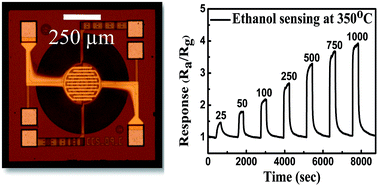Dip pen nanolithography-deposited zinc oxide nanorods on a CMOS MEMS platform for ethanol sensing
Abstract
This paper reports on the novel deposition of zinc oxide (ZnO) nanorods using a dip pen nanolithographic (DPN) technique on SOI (silicon on insulator) CMOS MEMS (micro electro mechanical system) micro-hotplates (MHP) and their characterisation as a low-cost, low-power ethanol sensor. The ZnO nanorods were synthesized hydrothermally and deposited on the MHP that comprise a tungsten micro-heater embedded in a dielectric membrane with gold interdigitated electrodes (IDEs) on top of an oxide passivation layer. The micro-heater and IDEs were used to heat up the sensing layer and measure its resistance, respectively. The sensor device is extremely power efficient because of the thin SOI membrane. The electro-thermal efficiency of the MHP was found to be 8.2 °C mW−1, which results in only 42.7 mW power at an operating temperature of 350 °C. The CMOS MHP devices with ZnO nanorods were exposed to PPM levels of ethanol in humid air. The sensitivity achieved from the sensor was found to be 5.8% ppm−1 to 0.39% ppm−1 for the ethanol concentration range 25–1000 ppm. The ZnO nanorods showed an optimum response at 350 °C. The CMOS sensor was found to have a humidity dependence that needs consideration in real-world application. The sensors were also found to be selective towards ethanol when tested in the presence of toluene and acetone. We believe that the integration of ZnO nanorods using DPN lithography with a CMOS MEMS substrate offers a low cost, low power, smart ethanol sensor that could be exploited in consumer electronics.


 Please wait while we load your content...
Please wait while we load your content...